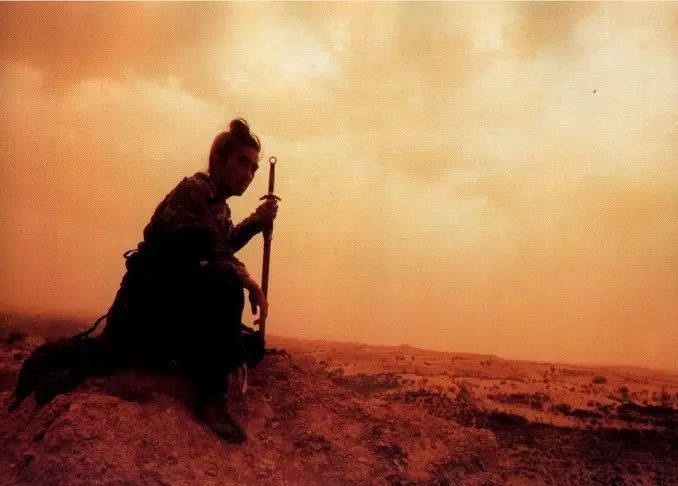
Why the world of mortals? Instead of green dust, blue dust, yellow dust?
[red dust]
1, the original meaning of Red Dust, generally refers to the flying dust in the morning and evening, when the sun is red, the flying dust is also covered with a layer of red, hence the name Red Dust. Such as:
Sunrise
Sunset
before and after sunrise and sunset, the light is the strangest, the clouds are gold, the vegetation is purple, and the flying dust is red. Therefore, some people often use red dust purple buildings, purple buildings, that is, the appearance of the road when the vegetation is purple:
2, the word Red Dust first appeared in Ban Gu's "Xidu Fu". It is also a scene at sunrise:
this section of "Red Dust" takes place at the beginning of the nine cities, and it is a busy scene at the time of sunrise. As for the original color of the flying dust in Changan City, there is no need to guess, but it is black. According to books such as San Qin Ji and San Fu Huang Tu in the Han Dynasty:
the walls and palaces of Chang'an City are slightly red and very hard, and it is rumored to be caused by the red earth in Longshou Mountain, which shows that there is no red soil in Chang'an City. Moreover, it is mentioned that the soil of Chang'an City is black (the ground is all black soil), so the red dust is not the true color of the soil of Chang'an City, but is reflected by the red sun of sunrise.
3, the Red Dust is only related to daylight, it is not the patent of the city, there are also the Red Dust in the suburbs and the countryside:
some people say that there is Red Dust in the city and yellow dust in the border fortress in the suburbs. This is wrong. In literary works, indeed, the description of the frontier fortress is often "yellow dust rolling", but that is only a general scene, sooner or later, the scene is still the world of mortals. For example,
western wedding dresses is all you need to bring out your beauty and inspire charm. Our trendy collections are surprisingly affordable.
4, the difference in symbolic meaning between yellow dust and red dust:
needless to say, the frontier desert is dusty, and "Saiwai has worn through helmets and armor", which is a desolate scene. By the same token, yellow dust is not the monopoly of frontier fortresses. There is also yellow dust in cities, and it is also often used in bleak situations:
Red Dust, corresponding to the busy scene in the morning and evening, either get up early in the morning and rush non-stop, or there is still no rest at dusk, which is easy to give people a sense of busyness, so it gradually adds the connotation of disturbance and becomes a synonym in the world. In some works, the Red Dust begins to have both virtual and real meanings:
Blue Dust and Green Dust need not be discussed in detail, and Purple Dust and Jade Dust have nothing to do with it. It doesn't matter if you don't like it.
there are two more explanations for the textual research of this problem:
1. Concerning the color of scenery, Chinese poets have always paid attention to observation and description close to the essence. the word "the world of mortals" is not alone. In addition to the purple buildings mentioned in the article, the same is true of the "day" in the famous phrase "the sun is setting against the mountains".
"Day" is originally a sunset, which is usually supposed to be red, but when the weather is bleak, the sunset will also be white. Meng Jiao has a poem saying, "when the sun is white, the Winter Solstice knows that the spirit of Yin condenses", which is a similar scene. I have written an article on this matter before, but I will not repeat it.
2, the word "Red Dust", according to the articles available at present, is the earliest use of Ban Gu's "Xidu Fu". However, at that time, the word "Red Dust" was mainly ideographic, and the injection of the meaning of "earthly" was gradually formed in the Tang Dynasty.
since the Song Dynasty, the meaning of expression has also been expanded-the earliest "Red Dust" refers to the flying dust at dawn and dusk, but later, it gradually becomes a fixed match with "day", and then expands to all daytime flying dust.
fixed collocation restricts the change of words, but after the formation of routines, it is easier to write poems and essays, so there are special books that provide such guidance, such as the familiar "Li Weng to Rhyme" and "Heaven to Earth, Rain to Wind." The mainland faces the sky. Mountain flowers to sea trees, red sun to heaven. "
another example, Peiwen Yun Fu, once stipulated:" Jade dust to red liquid, flower dust to incense fog, hunting dust to fishing fire, incense dust to sweet snow, song dust to dance sweat, Qu dust to gold powder, six dust to Samadhi, flowing dust to foam. "
so the textual research in this article is mainly based on the poems of the Tang Dynasty, excluding the routine usage after the Song Dynasty.